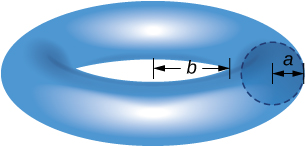1.8E: Exercises
( \newcommand{\kernel}{\mathrm{null}\,}\)
In exercises 1 - 4, find the weight of the one-dimensional object.
1) A wire that is 2 ft long (starting at x=0) and has a weight density function of γ(x)=x2+2x lb/ft
2) A car antenna that is 3 ft long (starting at x=0) and has a weight density function of γ(x)=3x+2 lb/ft
- Answer
- 392 lbs.
3) A metal rod that is 8 in. long (starting at x=0) and has a weight density function of γ(x)=e1/2x lb/in.
4) A pencil that is 4 in. long (starting at x=2) and has a weight density function of γ(x)=5x oz/in.
- Answer
- ln(243) oz.
5) Using the Left Endpoint Method with n=6, approximate the weight of a one-dimensional ruler that is 12 in. long (starting at x=5) and has a weight density function of γ(x)=ln(x)+(1/2)x2 oz/in.
In exercises 6 - 7, find the weight of the two-dimensional object that is centered at the origin.
6) An oversized hockey puck of radius 2 in. with radial weight density function γ(x)=x3−2x+5 lb/in2.
- Answer
- 332π15 lbs.
7) A disk of radius 5 cm with radial weight density function γ(x)=√3x g/cm2
- Answer
- 20π√15 g.
8) Using the Right Endpoint Method with n=6, approximate the weight of a two-dimensional frisbee (centered at the origin) of radius 6 in. with radial weight density function γ(x)=e−x oz/in2.
In exercises 9 - 14, calculate the center of mass for the collection of masses given.
9) m1=2 at x1=1 and m2=4 at x2=2
10) m1=1 at x1=−1 and m2=3 at x2=2
- Answer
- x=54
11) m=3 at x=0,1,2,6
12) Unit masses at (x,y)=(1,0),(0,1),(1,1)
- Answer
- (23,23)
13) m1=1 at (1,0) and m2=4 at (0,1)
14) m1=1 at (1,0) and m2=3 at (2,2)
- Answer
- (74,32)
In exercises 15 - 24, compute the center of mass ˉx.
15) ρ=1 for x∈(−1,3)
16) ρ=x2 for x∈(0,L)
- Answer
- 3L4
17) ρ=1 for x∈(0,1) and ρ=2 for x∈(1,2)
18) ρ=sinx for x∈(0,π)
- Answer
- π2
19) ρ=cosx for x∈(0,π2)
20) ρ=ex for x∈(0,2)
- Answer
- e2+1e2−1
21) ρ=x3+xe−x for x∈(0,1)
22) ρ=xsinx for x∈(0,π)
- Answer
- π2−4π
23) ρ=√x for x∈(1,4)
24) ρ=lnx for x∈(1,e)
- Answer
- 14(1+e2)
In exercises 25 - 27, compute the center of mass (ˉx,ˉy). Use symmetry to help locate the center of mass whenever possible.
25) ρ=7 in the square 0≤x≤1,0≤y≤1
26) ρ=3 in the triangle with vertices (0,0),(a,0), and (0,b)
- Answer
- (a3,b3)
27) ρ=2 for the region bounded by y=cos(x),y=−cos(x),x=−π2, and x=π2
In exercises 28 - 34, use a calculator to draw the region, then compute the center of mass (ˉx,ˉy). Use symmetry to help locate the center of mass whenever possible.
28) [Technology Required] The region bounded by y=cos(2x),x=−π4, and x=π4
- Answer
- (0,π8)
29) [Technology Required] The region between y=2x2,y=0,x=0, and x=1
30) [Technology Required] The region between y=54x2 and y=5
- Answer
- (0,3)
31) [Technology Required] Region between y=√x,y=lnx,x=1, and x=4
32) [Technology Required] The region bounded by y=0 and x24+y29=1
- Answer
- (0,4π)
33) [Technology Required] The region bounded by y=0,x=0, and x24+y29=1
34) [Technology Required] The region bounded by y=x2 and y=x4 in the first quadrant
- Answer
- (58,13)
In exercises 35 - 39, use the Theorem of Pappus to determine the volume of the shape.
35) Rotating y=mx around the x-axis between x=0 and x=1
36) Rotating y=mx around the y-axis between x=0 and x=1
- Answer
- V=mπ3 units³
37) A general cone created by rotating a triangle with vertices (0,0),(a,0), and (0,b) around the y-axis. Does your answer agree with the volume of a cone?
38) A general cylinder created by rotating a rectangle with vertices (0,0),(a,0),(0,b), and (a,b) around the y-axis. Does your answer agree with the volume of a cylinder?
- Answer
- V=πa2b units³
39) A sphere created by rotating a semicircle with radius a around the y-axis. Does your answer agree with the volume of a sphere?
In exercises 40 - 44, use a calculator to draw the region enclosed by the curve. Find the area M and the centroid (ˉx,ˉy) for the given shapes. Use symmetry to help locate the center of mass whenever possible.
40) [Technology Required] Quarter-circle: y=√1−x2,y=0, and x=0
- Answer
- (43π,43π)
41) [Technology Required] Triangle: y=x,y=2−x, and y=0
42) [Technology Required] Lens: y=x2 and y=x
- Answer
- (12,25)
43) [Technology Required] Ring: y2+x2=1 and y2+x2=4
44) [Technology Required] Half-ring: y2+x2=1,y2+x2=4, and y=0
- Answer
- (0,289π)
45) Find the generalized center of mass in the sliver between y=xa and y=xb with a>b. Then, use the Pappus theorem to find the volume of the solid generated when revolving around the y-axis.
46) Find the generalized center of mass between y=a2−x2,x=0, and y=0. Then, use the Pappus theorem to find the volume of the solid generated when revolving around the y-axis.
- Answer
- Center of mass: (a6,4a25),
Volume: 2πa49 units³
47) Find the generalized center of mass between y=bsin(ax),x=0, and x=πa. Then, use the Theorem of Pappus to find the volume of the solid generated when revolving around the y-axis.
48) Use the Theorem of Pappus to find the volume of a torus (pictured here). Assume that a disk of radius a is positioned with the left end of the circle at x=b,b>0, and is rotated around the y-axis.

- Answer
- Volume: V=2π2a2(b+a)
49) Find the center of mass (ˉx,ˉy) for a thin wire along the semicircle y=√1−x2 with unit mass. (Hint: Use the Theorem of Pappus.)
Contributors
Gilbert Strang (MIT) and Edwin “Jed” Herman (Harvey Mudd) with many contributing authors. This content by OpenStax is licensed with a CC-BY-SA-NC 4.0 license. Download for free at http://cnx.org.


